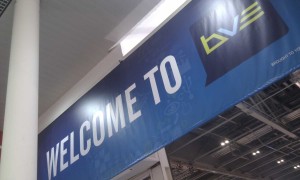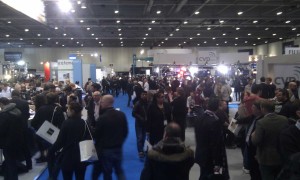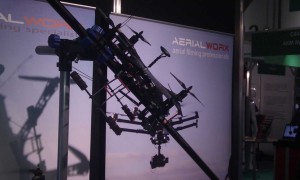 Given that the BSC Show at Pinewood a month or so back was so Alexa-heavy, one might reasonably have expected any big announcement ARRI intended to make to be made there, among the more expensive end of the film and TV market. In the end, though, they announced the miniaturized Alexa in time for BVE. As one nameless exhibitor opined, NAB is such a magnet for big announcements that this timing actually makes a lot of sense, and it’s nice to think that things could be spread out over the year a little more.
Given that the BSC Show at Pinewood a month or so back was so Alexa-heavy, one might reasonably have expected any big announcement ARRI intended to make to be made there, among the more expensive end of the film and TV market. In the end, though, they announced the miniaturized Alexa in time for BVE. As one nameless exhibitor opined, NAB is such a magnet for big announcements that this timing actually makes a lot of sense, and it’s nice to think that things could be spread out over the year a little more.
Having moved from Earl’s Court to the ExCeL Exhibition Centre in the east of London a few years ago, BVE is a slightly more general, but still nicely compact show in which even the largest exhibitors don’t have booths that require a map, a compass and three days’ supplies to navigate. This is in general a good thing, since it requires even big companies to consider their selection of exhibits carefully, and seems to improve the signal-to-noise ratio of the show. In this vein, anyone approaching ARRI’s booth would have been confronted not by the mini Alexa, but instead by the big, powerful L10-C LED fresnel. Consuming 400W, this is among the most powerful solid-state lights currently available (compare, for instance, to Litepanels‘ Sola 12, at under 350W) and may represent something of a milestone in the technology.
 Over at Canon‘s booth we see the first public showing of their new CN20x50 servo zoom. While one might gently query a 50mm wide end–which isn’t particularly wide by news standards, at least on Super35 sensors – the lens, with prices floating around $70,000, probably isn’t really intended to be thrown on the operator’s shoulder anyway. Given the large 20:1 zoom ratio and 1.5x extender, facilitating 50 to 1000mm focal lengths, there’s a lot of capability there, especially given that Canon confidently describe the lens as maintaining optical performance suitable for shooting 4K even with the extender engaged, something adapted ENG lenses often can’t match. One thing that remains missing from Canon’s booth and from Fujifilm‘s selection of both ENG and cinema lenses, however, is a lower-cost Super35 servo zoom. As trade shows go by, it’s perhaps a little disappointing to see that the only people who have anything approaching an affordable, owner-operable ENG-style zoom is Sony with its 28-135mm f/4 lens, available in an E mount that makes it difficult to use on other cameras. A hole in the market, perhaps.
Over at Canon‘s booth we see the first public showing of their new CN20x50 servo zoom. While one might gently query a 50mm wide end–which isn’t particularly wide by news standards, at least on Super35 sensors – the lens, with prices floating around $70,000, probably isn’t really intended to be thrown on the operator’s shoulder anyway. Given the large 20:1 zoom ratio and 1.5x extender, facilitating 50 to 1000mm focal lengths, there’s a lot of capability there, especially given that Canon confidently describe the lens as maintaining optical performance suitable for shooting 4K even with the extender engaged, something adapted ENG lenses often can’t match. One thing that remains missing from Canon’s booth and from Fujifilm‘s selection of both ENG and cinema lenses, however, is a lower-cost Super35 servo zoom. As trade shows go by, it’s perhaps a little disappointing to see that the only people who have anything approaching an affordable, owner-operable ENG-style zoom is Sony with its 28-135mm f/4 lens, available in an E mount that makes it difficult to use on other cameras. A hole in the market, perhaps.
One workaround to this problem is offered by London-based MTF Services, whose trade show booths are filled with so many varieties of lens mount adaptor that they end up resembling a finger buffet of finely-machined metal surfaces. The company makes adaptors both with and without corrective optics which permit ENG-style glass in the B4 mount to be used with popular large-sensor cameras, as well as more or less every other adaptation between stills, cine and broadcast lenses that’s mechanically feasible, so there are solutions.
 All of this, though, overlooks the carbon fibre elephant in the room; more than at any previous time, BVE establishes 2015 as the year in which remotely-operated aerial vehicles – drones – became mainstream, with both SeaHawk and AerialWorx present. While such things have been shown before, and there has been no enormous leap in the available technology, several companies were showing examples of both the aircraft and the work they produce. The keen emphasis on safety and regulatory compliance is reassuring, although changes to the relevant legislation in various jurisdictions could make things complicated and there is a healthy apprehension about what will happen if a serious accident does occur. Still, with modern, high-precision GPS technology running the show, the ability of modern remote air vehicles to repeatably and precisely fly shots–which is a safety as well as an artistic concern–is enormously in advance of what was available even a few years ago, to the chagrin of some crane operators.
All of this, though, overlooks the carbon fibre elephant in the room; more than at any previous time, BVE establishes 2015 as the year in which remotely-operated aerial vehicles – drones – became mainstream, with both SeaHawk and AerialWorx present. While such things have been shown before, and there has been no enormous leap in the available technology, several companies were showing examples of both the aircraft and the work they produce. The keen emphasis on safety and regulatory compliance is reassuring, although changes to the relevant legislation in various jurisdictions could make things complicated and there is a healthy apprehension about what will happen if a serious accident does occur. Still, with modern, high-precision GPS technology running the show, the ability of modern remote air vehicles to repeatably and precisely fly shots–which is a safety as well as an artistic concern–is enormously in advance of what was available even a few years ago, to the chagrin of some crane operators.
The combination of modern drones and the new miniature Alexa is something that became feasible at BVE 2015, and if that potent combination were the only thing to come out of the show, we’d still be pleased. Perhaps we should approach NAB with the expectation of even more flying machines. And, perhaps, a hat with an anti-collision strobe on it.





